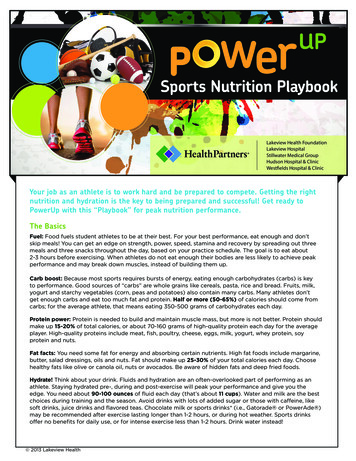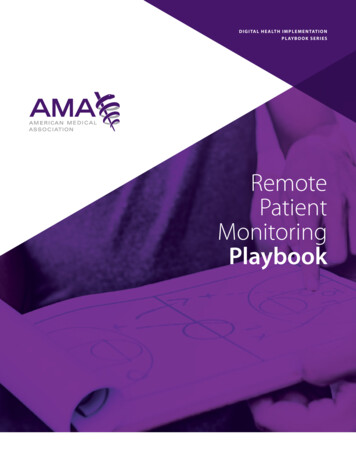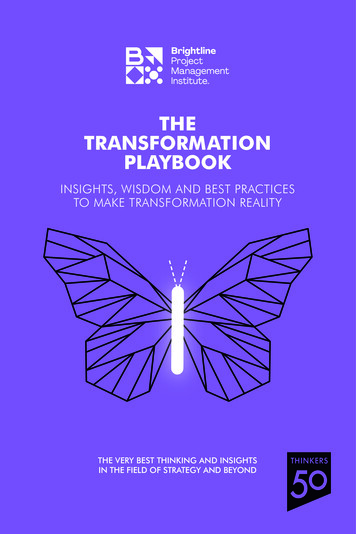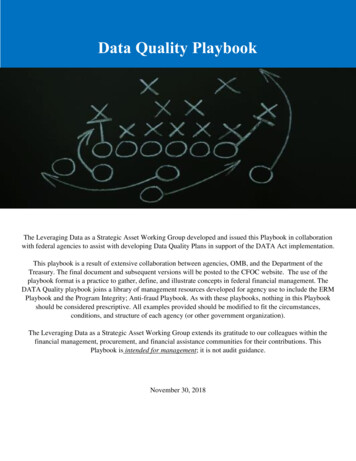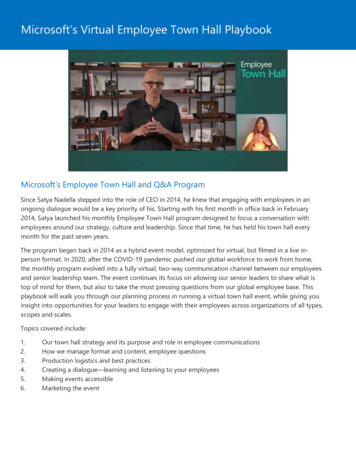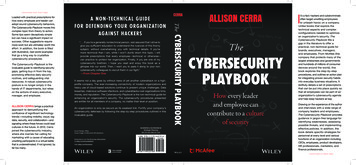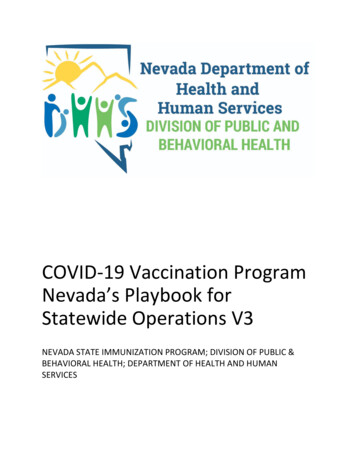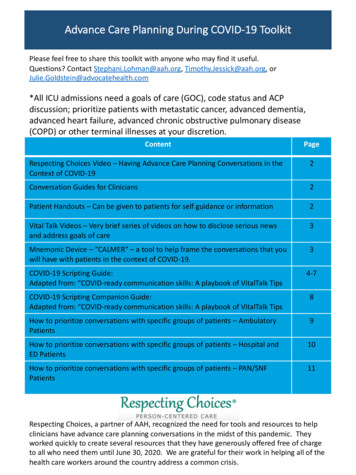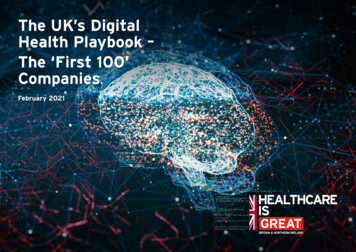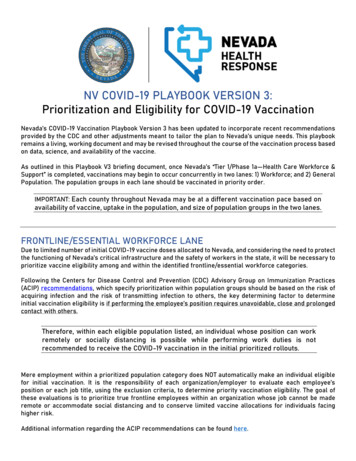
Transcription
NV COVID-19 PLAYBOOK VERSION 3:Prioritization and Eligibility for COVID-19 VaccinationNevada’s COVID-19 Vaccination Playbook Version 3 has been updated to incorporate recent recommendationsprovided by the CDC and other adjustments meant to tailor the plan to Nevada’s unique needs. This playbookremains a living, working document and may be revised throughout the course of the vaccination process basedon data, science, and availability of the vaccine.As outlined in this Playbook V3 briefing document, once Nevada’s “Tier 1/Phase 1a—Health Care Workforce &Support” is completed, vaccinations may begin to occur concurrently in two lanes: 1) Workforce; and 2) GeneralPopulation. The population groups in each lane should be vaccinated in priority order.IMPORTANT: Each county throughout Nevada may be at a different vaccination pace based onavailability of vaccine, uptake in the population, and size of population groups in the two lanes.FRONTLINE/ESSENTIAL WORKFORCE LANEDue to limited number of initial COVID-19 vaccine doses allocated to Nevada, and considering the need to protectthe functioning of Nevada’s critical infrastructure and the safety of workers in the state, it will be necessary toprioritize vaccine eligibility among and within the identified frontline/essential workforce categories.Following the Centers for Disease Control and Prevention (CDC) Advisory Group on Immunization Practices(ACIP) recommendations, which specify prioritization within population groups should be based on the risk ofacquiring infection and the risk of transmitting infection to others, the key determining factor to determineinitial vaccination eligibility is if performing the employee’s position requires unavoidable, close and prolongedcontact with others.Therefore, within each eligible population listed, an individual whose position can workremotely or socially distancing is possible while performing work duties is notrecommended to receive the COVID-19 vaccination in the initial prioritized rollouts.Mere employment within a prioritized population category does NOT automatically make an individual eligiblefor initial vaccination. It is the responsibility of each organization/employer to evaluate each employee’sposition or each job title, using the exclusion criteria, to determine priority vaccination eligibility. The goal ofthese evaluations is to prioritize true frontline employees within an organization whose job cannot be maderemote or accommodate social distancing and to conserve limited vaccine allocations for individuals facinghigher risk.Additional information regarding the ACIP recommendations can be found here.
A standardized criteria list and current CDC guidance was used to determine the groups populating thefollowing priority lists:1.2.3.4.5.6.7.Level of exposure to COVID-19a. Population has unavoidable, close contact with those who may have COVID-19Length of exposurea. Population has unavoidable, sustained contact with those who may have COVID-19Importance of job/special technical skilla. Population has a special technical skill that is not easily replaced (i.e., doctor, meat packingplant employee, utility worker, teacher)b. Population has a job that others in the community depend on for overall community safety andwell-beingLikelihood of increasing community spreada. Populations that would increase spread within the community or within a closed, residentialfacilityMortality ratea. Population has an increased likelihood of death from COVID-19Morbidity ratea. Population has an increased likelihood of COVID-19 infectionImmune responsea.Vaccine shown to provide a proper immune response in the population vaccinated (e.g., olderpeople often do not show a strong immune response to vaccination)CURRENTLY VACCINATING:.TIER 1/PHASE 1A HEALTH CAREWORKFORCE AND SUPPORTUpon completion of Tier 1, vaccinations maybegin to occur concurrently in the followingtwo lanes:Essential Workforce& General PopulationThe population groups in each lane will bevaccinated in priority order
VACCINATION PRIORITY GROUP DESCRIPTIONSHealth Care Workforce and SupportThe health care workforce includes paid and non-paid clinical and non-clinical employees, volunteers,interns, etc. General Medical & Surgical HospitalPsychiatric & Substance Abuse HospitalsEmergency Medical Services PersonnelFrontline Public Health WorkforceLaboratory WorkersPharmacists & Pharmacy TechniciansOutpatient & Home Health ProvidersLong Term Care Facility Staff & Residents (LTCF)LTCF’s include nursing homes, skilled nursing facilities, behavioral health centers, and assisted livingfacilities. Individuals with disabilities living in group settings will be prioritized within this group. Thesesettings include Intensive Supported Living Arrangements (ISLA) and Supported Living Arrangements (SLA)for staff and residents.PUBLIC SAFETY & SECURITYNEVADA DEPARTMENT OF CORRECTIONSSTAFFLAW ENFORCEMENT, PUBLIC SAFETY ANDNATIONAL SECURITYNevada Department of Public Safety (DPS) andassociated Divisions (e.g., juvenile detention andprobation, parole and probation, Nevada HighwayPatrol, Division of Emergency Management, etc.);local Sheriffs’ Offices and Police Departments;School and University Police; Airport Police; otherpeace officers not specifically named; NevadaThreat Analysis Center; mission critical nationalsecurity workforce not covered by one of the fivefederal agencies receiving direct vaccine allocation.STATE AND LOCAL EMERGENCY OPERATIONSMANAGERS/STAFFFRONTLINE COMMUNITY SUPPORTEDUCATION (Pre-K & K-12) & CHILDCARE(public/private/charter school settings)Educators in pre-school and K-12 settings, includingteachers, aides, special education and special needsteachers, ESOL teachers, and para-educators;workers who provide services necessary to supporteducators/students, including but not limited toadministrators, administrative staff, IT staff, mediaspecialists, librarians, guidance counselors,
NEVADA SYSTEM OF HIGHER EDUCATION(NSHE) FRONTLINE EDUCATORS, STAFF &STUDENTSCOMMUNITY SUPPORT FRONTLINE STAFF (e.g.Frontline workers who support food, shelter,court/legal and social services, and othernecessities of life for needy groups andindividuals)essential workers in the Nevada Dept. of Education,etc.; workers who support the transportation andoperational needs of school settings, including busdrivers, crossing guards, cafeteria staff, cleaningand maintenance staff, and bus depot andmaintenance staff.Instructional and administrative faculty and all noninstructional staff types across the NSHE systemwho must work on campus, in close contact withothers, and who cannot and have not been able toconduct their job duties from home. Most of thisgroup includes medical and health faculty, staff, andstudents.Frontline workers who support food, shelter,court/legal services, and social services, and othernecessities of life for needy groups and individuals,including in-need populations and COVID19responders, including food bank distributors andfood preparers (if applicable), front-facing stateservice staff (e.g., DETR, WIC, DWSS, DMV, ADSD,etc.), community coalition advocates/volunteers inthe field (e.g., CHWs and others with publicinteraction).Veterinary nurses, technicians, veterinarians, andother services supporting individuals andorganizations with service animals, search andrescue dogs, and support animals.CONTINUITY OF GOVERNANCE (STATE & LOCAL)Essential, frontline workers who provide for thecontinuity of governance at the state and local level.ESSENTIAL PUBLIC TRANSPORTATIONPublic transportation system employees at the stateand local levels (urban, interurban, and rural transitauthorities), taxi and ride share services (e.g., Uber,Lyft, etc.), and other ground transport services notspecifically named.REMAINING ESSENTIAL PUBLIC HEALTHWORKFORCEPublic health and environmental health workersspecializing in sanitary and infection control, healthcare facility safety and emergency preparednessplanning, public health/community health workers(including call center workers) who conductcommunity-based public health functions,conducting epidemiologic surveillance andcompiling, analyzing, and communicating publichealth information, who cannot and have not beenworking from homeMORTUARY SERVICESWorkers who prepare the deceased for burial orinterment, conduct funerals, and/or operate sites orstructures reserved for interment or cremation
FRONTLINE SUPPLY CHAIN & LOGISTICSAGRICULTURE AND FOOD PROCESSINGFood manufacturer workers and their supplierworkers including those employed at foodingredient production and processing facilities;aquaculture and seafood harvesting facilities;slaughter and processing facilities for livestock,poultry, and seafood; animal food manufacturing andprocessing facilities; human food facilities producingby-products for animal food; industrial facilitiesproducing co-products for animal food; beverageproduction facilities; the production of foodpackaging; and workers supporting agricultureirrigation infrastructure.Farmers, farm and ranch workers, and agribusinesssupport services, including workers involved inauction and sales; in food operations, includinganimal food, grain and oilseed storage, handling,and processing; in ingredient production; inmanufacturing of veterinary drugs and biologics(e.g., vaccines).Animal agriculture workers to include thoseemployed in veterinary health (including thoseinvolved in supporting emergency veterinary orlivestock services); raising, caring for andmanagement of animals for food, as well as pets;animal production operations; livestock markets,slaughter and packing plants, manufacturers,renderers, and associated regulatory andgovernment workforceEND-TO-END ESSENTIAL GOODS SUPPLY Warehouses, processing, packaging, storage, andCHAIN (includes manufacturing, transport, distribution workforce (e.g., USPS, FedEx, UPS,messengers, truck drivers (local and long-haul),distribution and sale of essential items)wholesale traders, etc.); workers enabling the saleof human food (e.g., grocery stores), animal food(including pet food, animal feed, and rawmaterials/ingredients), and beverage products atgroceries, pharmacies, and convenience stores,including staff in retail customer support and ITsupport necessary for online orders, pickup, and/ordelivery; warehouse operators, including vendorsand support personnel critical for businesscontinuity (including heating, ventilation, and airconditioning (HVAC) and electrical engineers,security personnel, and janitorial staff), ecommerce or online commerce, and customerservice for essential functions.Essential Manufacturing Workers necessary for themanufacturing of materials and products needed formedical supply chains, and for supply chains
UTILITIES AND COMMUNICATIONSINFRASTRUCTUREassociated with transportation, energy,communications, food and agriculture, chemicalmanufacturing, nuclear facilities, the operation ofdams, water and wastewater treatment, emergencyservices, and the defense industrial base.Water and wastewater workers, dam workers,natural gas, energy/electric sectors, internet andmobile services, telephone service providers, newsbroadcasters (Radio and Television), newspaperpublishers, including back-office staff as well asfrontline journalists, and workers responsible forensuring persons with disabilities have access toand the benefits of communications platforms.NEVADA DEPARTMENT OF TRANSPORTATION &LOCAL EMERGENCY ROAD PERSONNELCDL operators, street cleanup crews, snowplowdrivers, district training officers, safety/loss controlsection, and traffic incident management,emergency road crews.ESSENTIAL AIRPORT OPERATIONSWorkers who support air transportation for cargoand passengers, including operation, distribution,maintenance, and sanitation. This includes air trafficcontrollers, flight dispatchers, maintenancepersonnel, ramp workers, fueling agents, flightcrews, airport safety inspectors and engineers,airport operations personnel, aviation andaerospace safety workers, security, commercialspace personnel, airport operations personnel,accident investigators, and flight instructors.OTHER ESSENTIAL TRANSPORTATIONVehicle repair, maintenance, and transportationequipment manufacturing and distribution facilities;workers critical to the manufacturing, distribution,sales, rental, leasing, repair and maintenance ofvehicles and other equipment and the supply chainsthat enable these operations to facilitate continuityof travel-related operations for essential workers.FRONTLINE COMMERCE & SERVICE INDUSTRIESFOOD SERVICE AND HOSPITALITYRestaurant and quick serve food operations,including dark kitchen and food prep centers, carryout, and delivery food workers.Workers in cafeterias used to feed workers or othercongregate settings not already captured in anoccupation group above. *Specific to Nevada:frontline casino and resort employees not in foodservice who have prolonged/sustained customerinteraction.
HYGIENE PRODUCTS AND SERVICESWorkers who produce hygiene products; workers inlaundromats, laundry services, and dry cleaners,workers providing personal and household goods,repair, and maintenance; workers providingdisinfection services for essential facilities andmodes of transportation and who support thesanitation of all food manufacturing processes andoperations from wholesale to retail; workersnecessary for the installation, maintenance,distribution, and manufacturing of water and spaceheating equipment and components; supportrequired for continuity of services, includingcommercial disinfectant services, janitorial andcleaning personnel, and support personnelfunctions that need freedom of movement to accessfacilities; workers supporting the production ofhome cleaning, pest control, and other essentialproducts necessary to clean, disinfect, sanitize, andensure the cleanliness of residential homes,shelters, and commercial facilities.DEPOSITORY CREDIT INSTITUTION WORKFORCEWorkers who are needed to provide, process, andmaintain systems for processing, verifying, andrecording financial transactions and services,including payment, clearing, and settlement;wholesale funding; insurance services; consumerand commercial lending; and public lending.Workers who are needed to provide business,commercial, and consumer access to bank and nonbank financial and/or lending services, includingATMs, lending and money transmission, lockboxbanking, and armored car services.FRONTLINE INFRASTRUCTUREINFRASTRUCTURE, SHELTER & HOUSING(CONSTRUCTION)Workers performing housing and commercialconstruction related activities, including thosesupporting the sale, transportation, and installationof manufactured homes. Workers supportinggovernment functions related to the building anddevelopment process, such as inspections,permitting, and plan review services that can bemodified to protect the public health, butfundamentally should continue and enable thecontinuity of the construction industry.Workers such as plumbers, electricians,exterminators, builders (including building andinsulation), contractors, HVAC Technicians,technicians for elevators, escalators and movingwalkways, landscapers, and other service providers
who provide services, including temporaryconstruction, that are necessary to maintainingsafety, sanitation, and essential operation ofresidences, businesses and buildings, such ashospitals and senior living facilitiesFrontline mining and processing operations andsupplier/vendor industries essential to suchoperations.ESSENTIAL MINING OPERATIONSOTHERCOMMUNITY SUPPORT ADMINISTRATIVE STAFFFood Bank, state service office (e.g., DETR, WIC,DWSS, DMV, ADSD, etc.), and Community Coalitionadministrative and other support staff who can andhave been working from home.NSHE STUDENTS LIVING IN CAMPUSSPONSORED RESIDENTIAL SETTINGS(e.g. dorms, campus-sponsored apartments,etc.)NSHE REMAINING WORKFORCEPEOPLE WITH UNDERLYING HEALTH CONDITIONSNSIP worked with PHP and the Chronic Disease Prevention and Health Promotion Section to identify peoplewith underlying health conditions; NSIP will continue to engage these partners to message about vaccineconfidence and availability to those with underlying health conditions. Additionally, NSIP reached out to awide variety of partners across the state seeking help in reaching this population once a vaccine is available,including health insurers who can easily and quickly reach covered members. NSIP maintains this list and isengaging partners in the planning process as appropriate. NSIP is using CDC guidance to identify the specificunderlying health conditions causing the person to be at increased risk for severe illness from COVID-19:CANCERDOWN SYNDROMECHRONIC KIDNEY DISEASEHEART CONDITIONS, SUCHAS HEART FAILURE,CORONARY HEART DISEASE,OR CARDIOMYOPATHIESCOPD (CHRONICOBSTRUCTIVE PULMONARYDISEASE), CYSTIC FIBROSIS,PULMONARY FIBROSIS, ANDOTHER CHRONIC LUNGDISEASESIMMUNOCOMPROMISEDFROM SOLID ORGANTRANSPLANTOBESITY (BODY MASSINDEX, BMI, OF 30-39) ANDSEVERE OBESITY (BMI OF 40OR GREATER)PREGNANCYSICKLE CELL DISEASETYPE 2 DIABETES MELLITUSSMOKING
Cancer – Anyone currently undergoing treatment for cancer is at increased risk for severe illness from COVID-19. People with cancer whoare treated with chemotherapy are at more risk because of their weakened immune system. An estimated 16,450 Nevadans were newlydiagnosed with cancer in 2020 (American Cancer Society Facts and Figures, 2020).Chronic Kidney Disease – Anyone with Chronic Kidney Disease at any stage is at increased risk for severe illness from COVID-19 becausethey have a weakened immune system.COPD (chronic obstructive pulmonary disease), Cystic Fibrosis, Pulmonary Fibrosis, and other chronic lung diseases – Anyone with COPDor a related chronic lung disease at any stage is at increased risk for severe illness from COVID-19 because they specifically have veryweak lung health, and COVID-19 is a respiratory disease (i.e., a disease that targets the lungs).Down Syndrome - Revisions were made on December 23, 2020 to reflect recent data supporting increased risk of severe illness amongpersons with Down syndrome from the virus that causes COVID-19.Heart conditions, such as heart failure, coronary heart disease, or cardiomyopathies – Anyone with any heart condition, includinghypertension (high blood pressure) or stroke, could have an increased risk for severe illness from COVID-19 because they have weakenedimmune systems. In Nevada, cardiovascular disease is the leading cause of disease and death among adults.Immunocompromised from solid organ transplant – Anyone who has had a solid organ transplant is at risk of having a weakened immunesystem, because the body is relearning with the new organ, which increases their risk for severe illness from COVID-19.Obesity (Body Mass Index, BMI, of 30-39) and Severe Obesity (BMI of 40 or greater) – Obesity and severe obesity are risk factors for manychronic conditions and increase a person’s risk of suffering severe illness from COVID-19. According to 2019 data from the Behavioral RiskFactors Surveillance System (BRFSS), approximately 30% of Nevada adults are considered obese based on BMI.Pregnancy - Based on what we know at this time, pregnant people are at increased risk for severe illness from COVID-19 compared tonon-pregnant people. Additionally, there might be an increased risk of adverse pregnancy outcomes, such as preterm birth, amongpregnant people with COVID-19.Sickle Cell Disease – Anyone who has been diagnosed with sickle cell disease is at increased risk for severe illness from COVID-19because they have a weakened immune system.Type 2 Diabetes mellitus – People who have a blood sugar level (A1C) between 5.7% and 6.4% are in the prediabetes stage and anyone withan A1C level higher than 6.5% is indicated to have diabetes. Having Type 2 diabetes, specifically, weakens the immune system and puts theperson at increased risk of severe illness from COVID-19. Having Type 1 or gestational diabetes might increase the risk of severe illness. In2019, approximately 11% of adults in Nevada reported being told by a health professional they have diabetes (excluding prediabetes andgestational diabetes).Smoking – Smoking is a risk factor for many chronic conditions and can increase a person’s risk for severe illness from COVID-19.Smoking weakens lung health and COVID-19 is a respiratory disease (i.e., a disease that targets the lungs). Both former (have smoked atleast 100 cigarettes in their lifetime) and current (smoke cigarettes every day or some days) smokers face heightened risk. From the mostrecent data available (2016 BRFSS), approximately 17% of adults in Nevada reported smoking.FREQUENTLY ASKED QUESTIONSQ: When will the general public be able to get vaccinated? How will I know when it’smy turn?A: Due to the limited supply, DHHS has prioritized how the vaccine will be distributed. Supply of the vaccine will increasesubstantially over the next few months. Those eligible to receive the vaccine will progress as supply increases. If you wouldlike to be notified when you are eligible for the vaccine, please complete this survey which will be shared with the jurisdictionwhere you live: Nevada COVID 19 Vaccine Interest Form Nevada will use a variety of methods to ensure that all Nevadans whoare interested in vaccination have access when it is their turn. That includes traditional media outlets, social media, healthcare provider offices, and community partners.Q: Why do we need a vaccine if physical distancing and wearing masks can helpprevent coronavirus spread?A: Stopping a pandemic requires using all the tools available. Vaccines work with your immune system so your body will beready to fight the virus if you are exposed. Other steps, like covering your mouth and nose with a mask and physicaldistancing, help reduce your chance of being exposed to the virus or spreading it to others. Together, COVID-19 vaccinationand following CDC’s recommendations to protect yourself and others will offer the best protection from COVID-19.
Q: How many shots of COVID-19 vaccine will be needed?A: The approved Pfizer-BioNTech vaccine and the Moderna vaccine in the United States both require two shots to be fullyeffective.Q: How will I know when to return for my second dose?A: The VaxText text messaging resource is a free service. By texting ENROLL to 1-833-829-8398, vaccine recipients can opt into receive a weekly text reminder for their second dose of COVID-19 vaccine or a reminder for when they are overdue for theirsecond dose, in English or Spanish.In addition to VaxText, the State of Nevada plans to use multiple ways to notify you of your second dose. COVID-19 vaccinationrecord cards (reminder cards) will be provided when you receive the COVID-19 vaccine. The card provides room for a writtenreminder for a second-dose appointment. If you have a smartphone, consider taking a photo of your vaccination record andentering the date the next vaccine dose is due in your calendar.To ensure the best protection from COVID-19, it is very important to not skip the second dose. The second dose must be fromthe same vaccine manufacturer, so it will be important to ensure that where you receive your second dose has the rightvaccine.Q: If I’ve recovered from COVID-19, do I still need to get a vaccine?A: Due to the severe health risks associated with COVID-19 and the fact that re-infection with COVID-19 is possible, people maybe advised to get a COVID-19 vaccine even if they have been sick with COVID-19 before. Individuals are advised to talk to theirhealth care provider about whether or not they should get vaccinated for COVID-19 if they have already had the virus. At thistime, experts do not know how long someone is protected from getting sick again after recovering from COVID-19. Theimmunity someone gains from having an infection, called natural immunity, varies from person to person. Some earlyevidence suggests natural immunity may not last very long. We won’t know how long immunity produced by vaccination lastsuntil we have a vaccine and more data on how well it works.Q: What are the side effects of the COVID-19 vaccine?A: Among the 36,000 people who have received an mRNA COVID-19 vaccine through phase 3 clinical trials (Moderna andPfizer-BioNTech trials), no serious safety concerns have been reported. Some participants reported transient side effectsincluding sore arm, fever, muscle pain and fatigue that resolved in 24 hours. Older adults reported fewer and milder sideeffects. In a small percentage of cases these side effects were severe — defined as preventing daily activities.For more information go to NVCOVIDFighter.org
manufacturing of veterinary drugs and biologics (e.g., vaccines). Animal agriculture workers to include those employed in veterinary health (including those involved in supporting emergency veterinary or livestock services); raising, caring for and management of animals for food, as well as pets; animal production operations; livestock markets,

